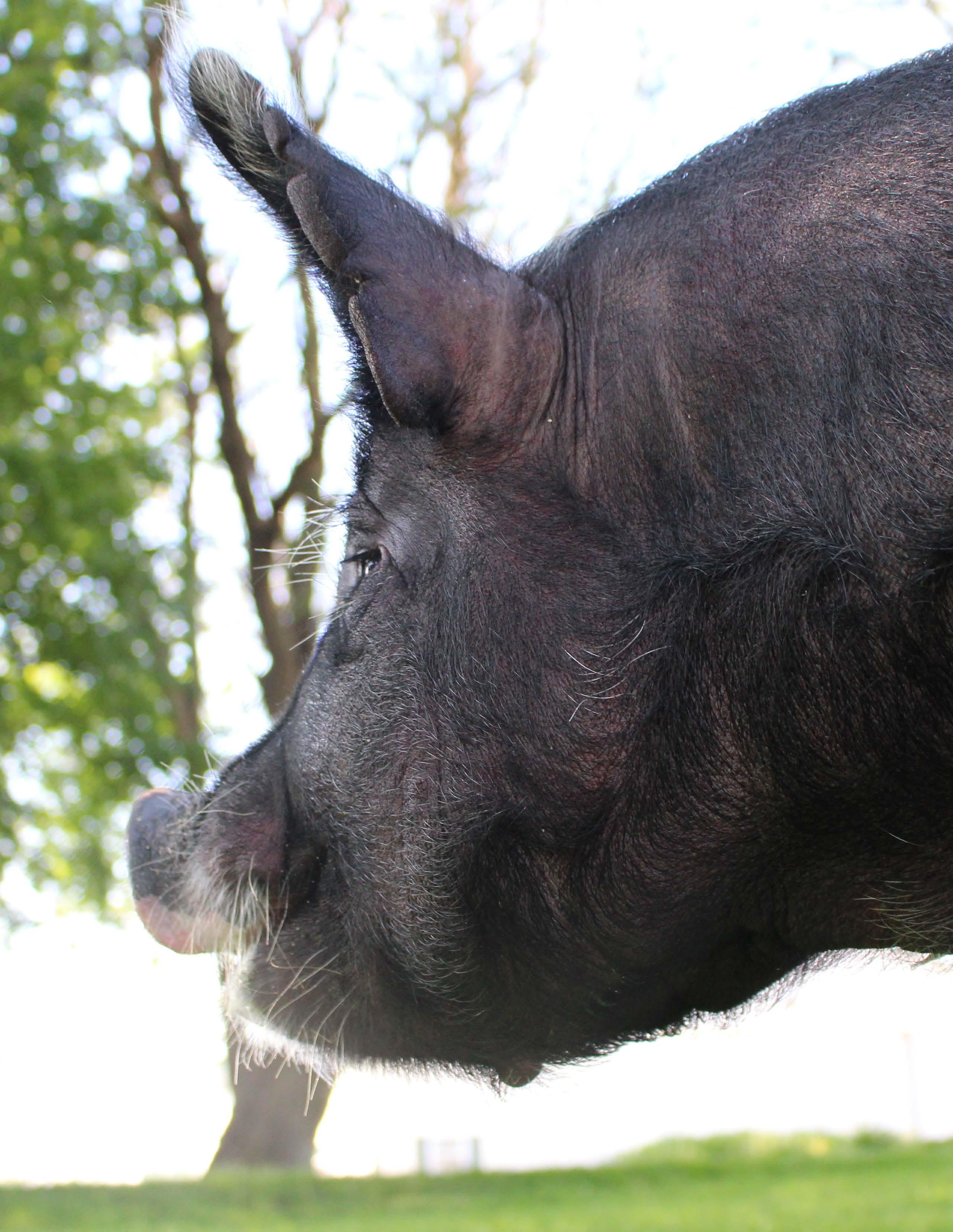
15 minute read
The Importance of Progeny
words by Mallorie Boggs
GLOSSARY
Advertisement
Progeny (prog·e·ny): offspring of animals or plants
Progeny Test: a test of the worth of a sire or some times of a dam based on the performance of its early progeny : an evaluation of the genotype of an animal in terms of its offspring
Genotype (ge·no·type): all or part of the genetic constitution of an individual or group
View full Progeny Test glossary terms online in the Sire Summary.
“Dictionary by Merriam-Webster: America’s Most-Trusted Online Dictionary.” MerriamWebster, Merriam-Webster, www.merriam-webster.com/.
Livestock producers pay attention to genetic pairing. Matching a sire with a specific dam gives the breeder a direct hand in making future generations better producers and better tasting. For Berkshires, the data gathered through progeny tests have given quantitative credibility to the slogan “superior taste to the discriminating dinners”.
What: The American Berkshire Association (ABA) progeny test is designed after the Hormel NBS Progeny Test so that Berkshire breeders can continue building upon the meat quality EPD database that we have assembled over the last 24 years (1991 to 2015). The Progeny Test was originally developed as a tool for swine breeders to objectively identify genetically superior purebred sires in each breed using thorough and unbiased testing and evaluation. These include evaluations of carcass composition, growth performance, meat quality and eating quality. Currently, twelve measures of progeny performance are recorded on every pig that completes the testing period. The ABA Progeny Test remains the most extensive unbiased evaluation of progeny performance available to Berkshire breeders.
Who: Any member of the ABA is welcome to enter registered Berkshire pigs. The ABA Progeny test wouldn’t be possible without ABA members, collaborators, and sponsors!
When: The ABA Progeny Test is annually conducted. Breeders who are entered deliver their pigs to be tested in April. At the start of the test, pigs weigh on average 70 lbs and are fed until ideal market weight.
Where: The progeny test is performed by Dr. Lindy Miller with LFM Quality Laboratories, Inc. in Terre Haute, Ind.
How: The pigs are organized by breeder in pens of eight pigs sired by the same boar. Dr. Lindy Miller and associates collect various data using industry standards throughout the test.
Why: The information that comes from the progeny test can be used in a breeders’ breeding and marketing program. This data is compiled and returned to participating breeders for use within their individual breeding or marketing program. Producers can use analytics in their future genetic pairings or to explain why Berkshire pork is superior when marketing their products.
2019 Progeny Test
100% BERKSHIRE PERFORMANCE SIRE INDEX 100% Berkshire Performance Sire Index represents 90% weight on Lean Growth measures and 10% weight on Eating Quality measures.


BREEDER SIRE TESTED PRIME PORK PERFORMANCE INDEX INDEX AJC Berkshires AJC6 Gaileo 19-1 102.5 116.1 Hodges Family Berkshires OHF6 Bigfoot 55-2 102.7 101.1 Fly’n K Berkshires HH5 Back Home 74-1 99.2 100.8 Fly’n K Berkshires HH5 Back Home 74-1 99.7 100.2 Fly’n K Berkshires 2REV7 Ol’ Son 39-2 100.5 99.0 England’s Berkshires EB7 Kruger 11-1 100.8 98.9 Petrik Farms BBW6 Red Chips 1-1 97.4 97.5 Fly’n K Berkshires FKB7 Swamp Donkey 40-7 98.9 93.0 Fly’n K Berkshires FKB7 Swamp Donkey 40-7 101.9 91.7 2019 Berkshire Test Averages 100.0 100.0 Berkshires ckHome74-1A Pen4: AJCBerkshires Sire: AJC6Gaileo19-1 ilyBerkshires ot55-2 Pen2: Fly'nKBe Sire: FKB7Swa
Fly’n K Berkshires HH5 Back Home 74-1










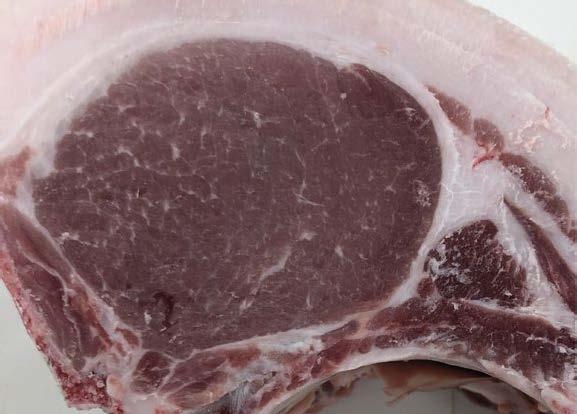



12345678 TestTag4 16 4174 18 4194 AJC Berkshires AJC6 Gaileo 19-1 Hodges Family Berkshires OHF6 Bigfoot 55-2
2019 Progeny Test Results
Click here to view the Test Summary packet.
100% BERKSHIRE PRIME PORK INDEX 100% Berkshire Prime Pork Index represents 10% weight on Lean Growth measures and 90% weight on Eating Quality measures.
BREEDER SIRE TESTED PRIME PORK PERFORMANCE INDEX INDEX Hodges Family Berkshires OHF6 Bigfoot 55-2 101.1 102.7 AJC Berkshires AJC6 Gaileo 19-1 116.1 102.5 Fly’n K Berkshires FKB7 Swamp Donkey 40-7 91.7 101.9 England’s Berkshires EB7 Kruger 11-1 98.9 100.8 Fly’n K Berkshires 2REV7 Ol’ Son 39-2 99.0 100.5 Fly’n K Berkshires HH5 Back Home 74-1 100.2 99.7 Fly’n K Berkshires HH5 Back Home 74-1 100.8 99.2 Fly’n K Berkshires FKB7 Swamp Donkey 40-7 93.0 98.9 Petrik Farms BBW6 Red Chips 1-1 97.5 97.4 erkshires 1 1-1 erkshires a mpDonkey40-7A





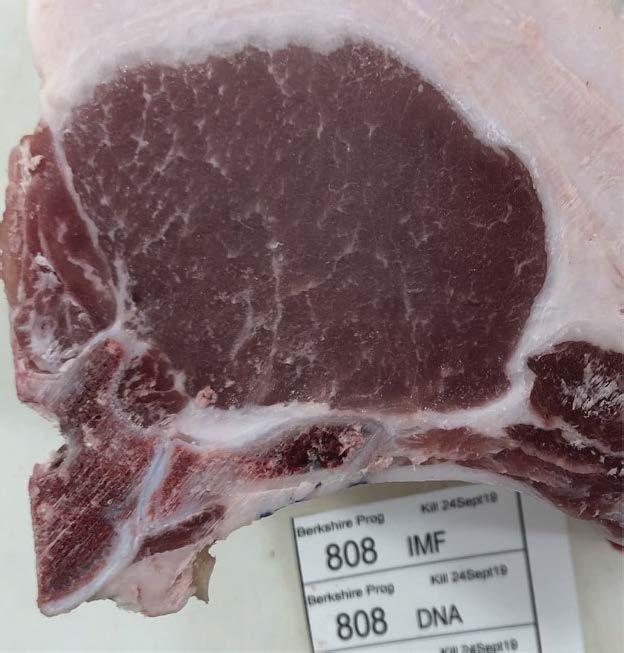



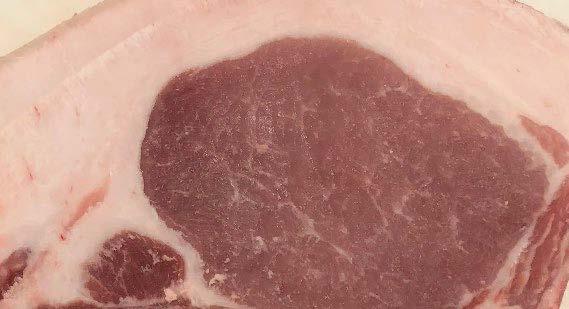


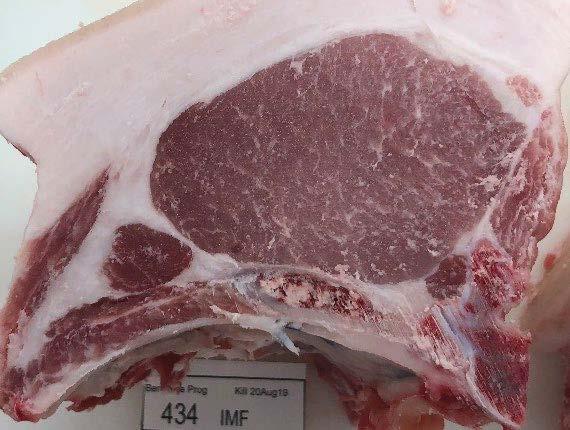

23 Experience Berkshire / Petrik Farms BBW6 Red Chips 1-1 345678 814 815 8168 17 8188 19 died England’s Berkshires EB7 Kruger 11-1 Fly’n K Berkshires 2REV7 Ol’ Son 39-2 12345678
406 407 805 806 807 808 died Fly’n K Berkshires FKB7 Swamp Donkey 40-7 Petrik Farms BBW6 Red Chips 1-1
AJC BERKSHIRES HOLDEN, MO / HERD: BAXTER, IA Adam & Julie Conover and Family, Al & Jeanne Conover Adam: 816-676-8560 Al: 515-491-8078 ajcberkshires.com
OAK HILL FARM JULIAN, NE Mike Hodges and Family 402-242-2191
ENGLAND’S BERKSHIRES CLEARFIELD, IA Doug & Pricilla England and Family 641-336-2925
PETRIK FARMS GAYVILLE, SD Jim & Sharon Petrik and Family 605-661-7179
FLY’N K BERKSHIRES ALVORD, IA Lance & Kristi Knobloch & Family 605-336-4385 flynkberks.com
Thank you to the 2019 supporters!


PROGENY TEST SPONSORS:
HOGS MUST GROW written by Chas. H. Nickel, manager Lynnwood Farm originally published in the January 1945 “Berkshire News”, pg. 85 and 86
Although this article was published 75 years ago, we believe that it is still relevant today. We at Patterson’s Registered Berkshires strive to breed Berkshires that meet characteristics, specifically, they are bred to grow.
It is probably almost heresy for one who has bred Berkshires for 30 years to even hint that there is anything that should be watched more closely in the breeding of Berkshires. However, unless we the breeders recognize the weakness of our own hogs, how then are we to improve them? I would not have devoted so much of my life to the breeding of the Berkshires, if I did not think they were the superior breed of hogs. They have inherent characteristics which set them apart from any other breed. Their high percentage of lean meat- fuller, meatier hams- larger eye of lean in the loin- their minimum of outside fat, which is visible to the eye in their firmness of fleshing, trimness and lack of loose skin and sloppiness are Berkshire characteristics. Berkshire herds are easier and cheaper to maintain because of their easy keeping qualities and grazing ability. Berkshire sows will become overloaded with fat on quantities of feed needed to maintain some other breeds. Berkshire pigs will thrive on less feed than any other if good quality pasture is available. Even under dry lot conditions, their efficiency has been demonstrated at Clemson College wherein three consecutive years less than 300 pounds of feed was required to make 100 pounds of grain from weaning to market weight. Berkshires are the most practical farmer’s hog. However, through the years, through various fads and fancies, it has been my observation that it is difficult to keep a large enough percentage of the hogs in the breed, of the kind most popular with the average practical pork producer. The Practical hog man has several very definite requisites in mind in the selection of his breeding hogs. Two of these which seem to stand out very clearly are: first, a hog that will reach market weight and acceptable market condition in the shortest possible time; and second, a hog that will raise the largest number of pigs per litter. Because these two qualities are uppermost in the minds of the pork producers, we should give them a lot of attention in our breeding of purebred Berkshires. A Berkshire, to be a good Berkshire, must first be a good hog from the farmer’s standpoint. Hogs that fain the most rapidly, almost without exception put on that weight the cheapest. To produce that sort of Berkshire, we must watch closely the characteristics that indicate a hog is a rapid grower. Nearly all of us are apt to overlook the type of Berk that gets out and grows, in favor of one that is over-refined. We are very likely to overemphasize some of the characteristics that have no bearing on the essentials of profitable pork production. If we are to have Berkshires that do well in the hands of the farmer, we must place the most emphasis on size for age. And, that doesn’t mean highly fitted hogs that weight enough, but rather on hogs with a lot of characteristics of the good doing kind- lots of bone under them, strong feet, pasterns and legs, and the legs out on the corners of their bodies. We need to watch closely the length of our hogs. True the shorter, dumpier kind may sometimes finish a little faster than the longer, better-balanced kind, but that

is not a lot in growing ability when we shorten the breed. Natural thickness must be watched closely. There is a world of difference between hogs that are thick because their bony structures are bred that way, and those that are thick because of extreme fitting. Hogs that have natural thickness and substance will do well under any average condition, while the overly refined one which has to be fat to have any thickness must have the best of conditions in order to do anything. Many breeders have over-emphasized the importance of head type. Many animals are sacrificed every year because of heads that were thought to be a bit too long or not dished enough, or the ears are a bit too heavy to suit the discriminating. If hogs like that have the essential thickness and all of the other indications of ruggedness, then they are far more valuable to the breed than the Berkshires whose head and ears have just the right turn but are lacking even in a small way some of the essentials necessary to profitable pork making. Again I repeat, a Berkshire to be a good Berkshire must first be a good hog from the farmer’s viewpoint. That viewpoint places primary emphasis on factors of production- rapid growth and prolificacy. As a breed, if we are to maintain and develop further our present position of high repute, we must always keep these factors uppermost in our minds. Make them grow, and have large litters first, then get all the other refinements you can. If we do, the Berkshire will always be a major factor in American hog production.
WHERE Production + Performance “MEAT” FKB:
FROM THE 2019 ABA PROGENY TEST...

FKB7 SWAMP DONKEY 40-7 2019 ABA PRIME PORK INDEX WINNER
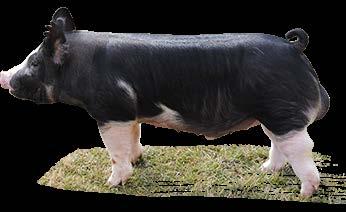
HH5 BACK HOME 74-1 2019 ABA PERFORMANCE SIRE INDEX WINNER
Semen available out of Swamp Donkey and all our Progeny Tested sires at SCSAi. Fly’n K Berkshires is the ONLY semen source in the USA with NBS/ABA Progeny Tested Berkshire boars that you can purchase semen from. These are actual tested boars not just descendants of a tested boar or boar that someone “thinks” is a meat quality boar.

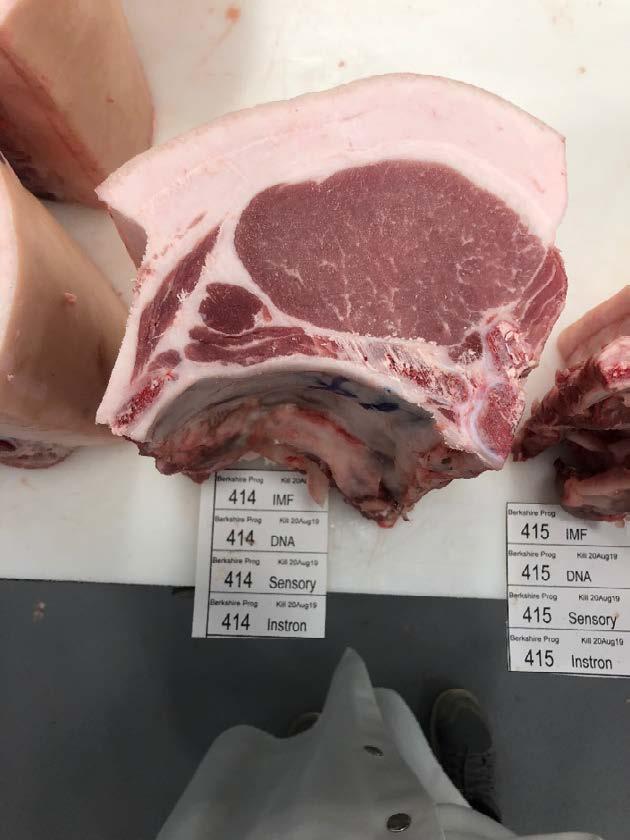




PROGENY TEST HIGHLIGHTS • Top 4 pens for Minolta Y and Minolta L darkest colored pork (Swamp Donkey and Back Home) • The #2 pen for Ultimate pH (Swamp Donkey) • The #1 and #2 pens for IMF % (Ol’ Son and Back Home) • The #2 pen for Instron Tenderness (Swamp Donkey) • The #2, #3, and #4 pens for Cooking Loss (Swamp Donkey and Back Home) • 2 pens tie for #1 in Sensory Juiciness (Ol’ Son and Swamp Donkey) • The #1 and #2 pens for Sensory Tenderness (Swamp Donkey and Ol’ Son) • 4 of the top 5 pens for Soundness (Ol’ Son, Back Home, Swamp Donkey) FKB7 SWAMP DONKEY 40-7 HH5 BACK HOME 74-1 2REV7 OL’ SON 39-2
LANCE & KRISTI KNOBLOCH KEEGAN, KELWIN, GABE, DAYTON

Bringing local sustenance to the table words by Mallorie Boggs
photo courtesy of Luke Wetzel

You know it’s a good restaurant when the first Google review starts with “Love this place! Try the olives. Seriously. You’ll be pleasantly surprised.” (Norma, from 3 weeks ago). That’s just one of many rave reviews of Oven & Tap. Located on Main St. this from-scratch, farm-to-table restaurant is a feature in Bentonville, Ark.’s food and social scene.
Behind the must-try olives, you’ll find the Founder, Owner, Creative of Oven & Tap, Chef Luke Wetzel. “I started Oven & Tap to share my vision of hospitality with the Northwest Arkansas area,” said Luke. “I named the restaurant Oven & Tap because it’s exactly who we are; no strings attached.”
Oven & Tap is centered around wood-fired cooking and a vast selection of libations. Luke carried this style of cooking from his time in the San Francisco Bay Area working at Chez Panisse. “Wood-oven cookery encourages a simplistic and honest style of food, which aligns with my food philosophies.”
The menu can be described as “southern fare with an Italian flair”. As a native to Arkansas, Luke took his southern upbringing and mixed it with his passion for Italian food. “Italian cooking is the school of cooking I subscribe to as a cook/chef/restaurateur. It’s the essence and the soul of the two cuisines that inspire the restaurant.”
No matter which way you look at it, Southern or Italian, both inspirations have a commonality: local products. Luke seeks local resources to bring back to his eatery every chance that he can.
His passion for local sustenance led him to connect with a local Berkshire producer, “We partnered with Bansley Berkshire Ridge Farm on Day 1 and they are part of Oven & Tap’s uniqueness and success”. Sean and Carol Bansley’s registered Berkshires are the source of numerous Berkshire pork items on Oven & Tap’s menu.
Luke has used Berkshire pork everywhere that he’s cooked. “Berkshire pork has been in the cooking industry narrative for as long as I can remember,” said Luke. “Each kitchen shares the same sentiment of its meat-to-fat ratio”.
photo courtesy of Oven & Tap

When Luke was planning for the opening of Oven & Tap, he sought out the Bansley’s and with a 30-minute phone call, their four years and counting partnership began.
Berkshire pork is responsible for one of the flagship plates on the menu- Berkshire Pork Meatballs. Between this dish and the Meatball Pizza, Oven & Tap uses 12 whole shoulders and 12 whole bellies every four weeks to make meatballs.
In addition to Berkshire pork, Oven & Tap works features a myriad of Arkansas products on their menu. From tomatoes to sweet corn, to lamb, chicken, and okra, the list of partnerships goes on. To be mindful of the farmer’s self-distribution schedule, Luke tries to keep regular, reliable orders so that producers can plan.
When asked about Oven & Tap’s customer responses to Berkshire pork, Luke said, “I change the menu quite often whether it is seasonal or just because I feel like it. But one thing we won’t change or remove is our meatballs. There would be riots in the streets! People absolutely love them.” Luke says that working with local farmers and sourcing local resources is the only way to do it. “Cooking from scratch with local ingredients will highlight a kitchen’s personality and skill and care, creating a unique selling position,” he said. “It’s the key to telling a story”.
The latter half of that previously mentioned Google review highlights the “Fresh ingredients, well-rounded menu, and friendly staff”. This couldn’t equate to the sum of Oven & Tap any more. •
Oven & Tap ovenandtap.com




